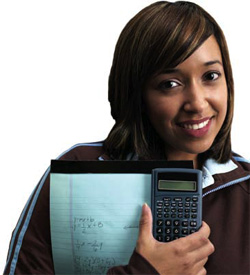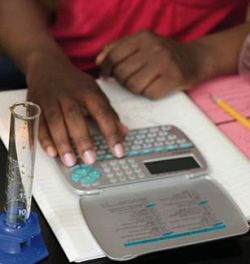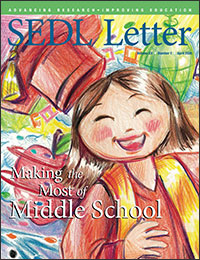Muddle in the Middle: Improving Math Instruction at the Middle School Level
Twenty years ago, the Internet didn’t exist as we know it today. Fifteen years ago, cell phones were rare. Ten years ago, no one had heard of an iPod. With technology expanding at an astounding rate, it’s becoming more and more important for students to learn—and understand—science and math. Unfortunately, this is one of the biggest issues educators are struggling with today.
Studies have indicated that U.S. students begin to fall behind in math once they reach middle school (Beaton et al., 1996; Schmidt, McKnight, & Raizen, 1997). Researchers have cited various reasons for this lack of achievement. Some say the curriculum in the United States isn’t focused, coherent, or rigorous (Beaton et al., 1996). Some say students aren’t motivated (Bishop & Mane, 2001). Still others point to the difficulties of teaching middle school students in general due to their emerging adolescence. Increasingly, however, researchers are focusing their efforts on determining not just students’ ability to learn or teachers’ ability to teach but what exactly teachers are teaching.

“There has been a lot of research on how to improve teaching. The research clearly indicates that teachers tend to teach how they were taught,” says Dr. Concepción Molina, a program associate at SEDL. “But what we have neglected is the hypothesis that teachers will also tend to teach what they were taught.”
The Mathematics Teaching in the 21st Century (MT21) study (Schmidt, 2007) found that middle school teachers in the United States are less prepared to teach math than many of their counterparts across the globe. The study, which surveyed 2,627 future teachers from 34 institutions in 6 countries, found that teachers in Taiwan and South Korea, for example, whose students perform well in international tests, take twice as many math courses as U.S. teachers during their training. These findings are consistent with those of the National Research Council (2001), which determined that U.S. elementary-school and middle school teachers have a limited knowledge and understanding of mathematics. These findings lead to an obvious question: Is a lack of teacher subject-matter knowledge causing our middle school students to fall behind in math?
How Bad Is the Problem?
There is no shortage of research demonstrating U.S. middle school students’ lack of achievement in mathematics, especially when compared to that of their peers in other nations. The Third International Mathematics and Science Study (TIMSS) examined the math performance of students in 41 countries. The study found that there is a clear drop in performance by U.S. students between the fourth and the eighth grades (Schmidt, McKnight, & Raizen, 1996). Perhaps more alarming, U.S. students went from above average in math in fourth grade to below average in eighth grade—and were the only students in the study to do so (the National Institute on Education Governance, Finance, Policymaking, and Management, 1998).

In an effort to understand why this decline in performance was occurring, many researchers began focusing on the curriculum. The National Research Council (2001) described the U.S. middle school mathematics curriculum as “shallow, undemanding, and diffuse in content coverage” (p. 4). In particular, U.S. teachers often focus on “the execution of paper-andpencil skills in arithmetic through demonstrations of procedures followed by repeated practice” (p. 4). In other words, teachers tend to focus on showing their students how to do math as opposed to explaining what mathematical concepts are and why they function as they do. Students know how to compute, but they don’t know what all that computation means and why it works that way; they can do the procedures but do not understand the associated concepts.
Research has shown that teachers, too, are more familiar with procedural math than conceptual math. According to the National Research Council (2001),
. . . recent studies have revealed that U.S. elementary and middle school teachers possess a limited knowledge of mathematics, including the mathematics they teach. The mathematical education they received, both as K–12 students and in teacher preparation, has not provided them with appropriate or sufficient opportunities to learn mathematics. As a result of that education, teachers may know the facts and procedures that they teach but often have a relatively weak understanding of the conceptual basis for that knowledge. (p. 372)
Researchers point out, however, that it’s not simply a matter of knowing the subject better or taking more classes. Schmidt (2007) states, “The obvious solution of having U.S. future teachers of middle school take more mathematics appears to be the answer, but it is only part of the answer” (p. 1). In fact, the MT21 study was designed to examine how middle school teachers are prepared in other countries, not their content knowledge. “It is quite revealing that the countries whose students continuously perform well on the international benchmark tests have the teachers who have been trained with extensive educational opportunities in mathematics as well as in the practical aspects of teaching mathematics to students in the middle grades,” Schmidt concluded (p. 42).
What Can Be Done?
Molina, a former mathematics teacher, has worked with mathematics teachers through his work at SEDL. He agrees that teachers’ lack of subject-matter knowledge in math is hurting middle school students, noting that while there has been a lot of research on how to improve teaching, there hasn’t been enough on how to improve what is being taught.
“If the teachers were only taught math based on procedures, then that is the mathematics they are going to teach,” Molina said. “They’re a product of the system. The whole idea of teachers not knowing the math as well as they should has flown under the radar.”
Conceptual knowledge refers to an “understanding of what a mathematics concept is, how and why it works the way it does, and what situations in real life model it” (Molina, 2004, p. 16). Molina cites the definition of pi as an example of procedural knowledge versus conceptual knowledge. A student might define pi as “3.14,” and this is certainly one answer. Defining pi as the ratio of the circumference to the diameter of a circle, however, involves a more thorough understanding.
“Even after three semesters of college calculus and other higher-level mathematics, I still only knew pi as the value 3.14. Of course I could plug it into formulas and get the correct answers, but it was not until I started teaching that I realized I really didn’t know what pi was conceptually,” Molina said. “We teach facts and procedures that are disconnected. Later, when students have to connect them, that’s when it starts getting tougher.”
Molina attributes this to three factors. First, when a teacher finishes college, it is assumed that he or she has the necessary subject-matter knowledge even though there is no guarantee that the required higher-level courses enable him or her to teach fundamental math. In fact, he notes, these courses often don’t go over many K–8 grade-level math topics because a deep understanding of those fundamentals is assumed or taken for granted. Second, once in the classroom, teachers are evaluated more on instructional strategies and classroom management than on content knowledge. Third, and most important according to Molina, teachers are not aware that they are lacking in knowledge.
“In their minds, they know it well,” Molina said. “In essence, they do not know that they do not know the mathematics. They have reached a false ceiling that they are not aware of because the system has not taken them to the top level of understanding of many critical math topics.”
For his dissertation, Molina (2004) conducted a case study to determine the depth of the subject-matter knowledge of four middle school mathematics teachers in Texas as well as their own perceived depth of knowledge. After a series of interviews and classroom observations, he determined that two of the four teachers had an inflated perception of their expertise. The educational system “failed to advance two of the four participants—and a third teacher to a partial extent—to a conceptual understanding of the mathematics topics tested” (Molina, 2004, p. 293).
Although he notes that the small sample size does not allow the conclusions to be generalized, Molina found his study reinforced the earlier research on teachers’ lack of mathematics content knowledge at the elementary school level. He found that “. . . the suggested conclusion is that college education failed to improve the middle school content expertise of the four teachers in this study. . . . middle school mathematics topics were, for the most part, ignored in the college preparation programs that certified these four teachers” (p. 292).
“It’s not the teachers’ fault,” Molina said. “What’s even more alarming is that the campus administrators went through the same system. They see nothing wrong with the shallow procedural mathematics that is being taught. When combined with a teacher appraisal system that has little if any focus on content knowledge, one can see why this issue has flown under the radar for so many years.”
Through his work at SEDL, Molina has conducted professional development for middle school mathematics teachers. He focused on improving the content knowledge of the mathematics they were teaching while simultaneously modeling research-based effective teaching practices such as the use of physical manipulatives. He says that by providing different perspectives, teachers can help students learn differently. He received good feedback from the teachers, and he would see a difference when he would follow up with them later.
“My participation in Dr. Molina’s Lesson Study Summer Institute for 2 consecutive years was an intense study of math that has allowed me to grow as a teacher of mathematics by first gaining a more profound understanding of fundamental mathematics as a learner,” said Lynda Francis, a fifth-grade teacher at Bale Elementary School in Little Rock, Arkansas. “Using physical models to represent many key concepts, Dr. Molina asked us to solve problems, justifying and communicating our reasoning through writing and group discussions. I believe by knowing more math, I have become a better teacher of students investigating mathematical ideas.”
Teaching middle school students is no easy matter regardless of the subject. Math in particular provides its own unique set of challenges. By teaching for deep conceptual understanding that connects to and supports the associated skills and procedures, middle school math teachers will provide their students with a more thorough grounding and foundation in fundamental but critical mathematics topics. In the process, they will help prepare their students for the more complex mathematics that awaits them in the higher grades.
References
- Beaton, A. E., Mullis, I. V. S., Martin, M. O., Gonzalez, E. J., Kelly, D. L., & Smith, T. A. (1996). Mathematics Achievement in the middle school years. Boston: TIMSS Study Center.
- Bishop, J. H., & Mane, F. (2001). The impacts of minimum competency exam graduation requirements on college attendance and early labor market success of disadvantaged students. In G. Orfield & M. L. Kornhaber (Eds.), Raising standards or raising barriers? Inequality and highstakes testing in public education (pp. 51–84). New York: The Century Foundation Press.
- Molina, C. (2004). A qualitative case study of the subject matter knowledge of Central Texas middle school mathematics teachers. Unpublished doctoral dissertation, Texas A&M University–Corpus Christi.
- National Institute on Education Governance, Finance, Policymaking, and Management. (1998). What the Third International Mathematics and Science Study (TIMSS) means for systemic school improvement (Publication No. 0-16-049826-0). Washington, DC: U.S. Government Printing Office.
- National Research Council. (2001). Adding it up: Helping children learn mathematics. J.Kilpatrick, J. Swafford, and B. Findell (Eds.). Mathematics Learning Study Committee, Center for Education, Division of Behavioral and Social Sciences and Education. Washington, DC: National Academy Press.
- Schmidt, W. H. (2007). The preparation gap: Teacher education for middle school mathematics in six countries (MT21 Report). East Lansing, MI: Michigan State University Center for Research in Mathematics and Science Education.
- Schmidt, W. H., McKnight, C. C., & Raizen, S. A. (1997). A splintered vision: An investigation of U.S. science and mathematics education. Dordrecht/Boston/London: Kluwer Academic Publishers.
Debbie Ritenour is a communications associate at SEDL.
Next Article: SEDL National Art Contest Winners

